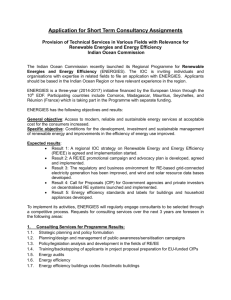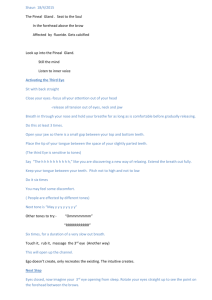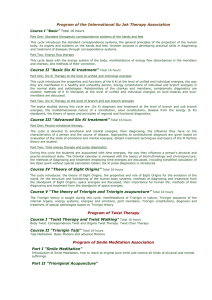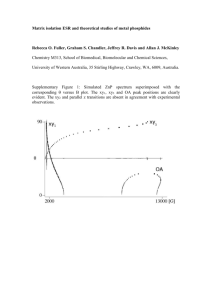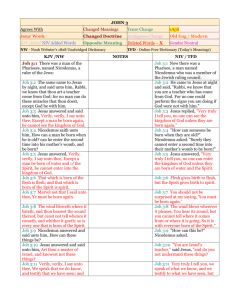150817 etheramides - Edinburgh Research Explorer
advertisement
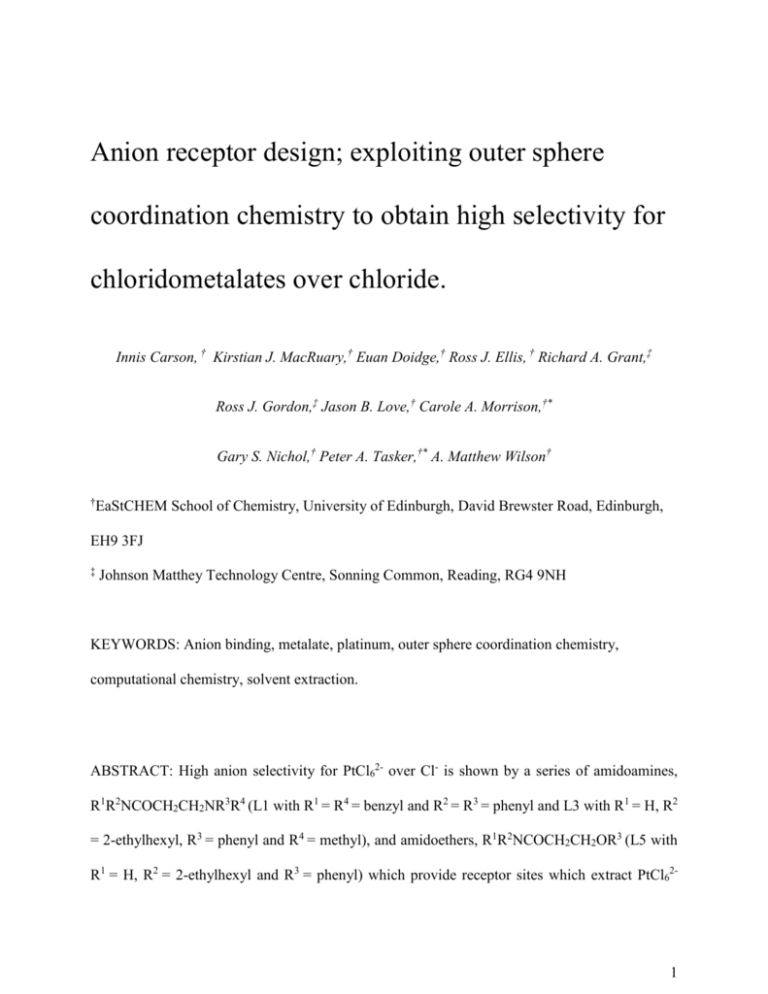
Anion receptor design; exploiting outer sphere
coordination chemistry to obtain high selectivity for
chloridometalates over chloride.
Innis Carson, † Kirstian J. MacRuary,† Euan Doidge,† Ross J. Ellis, † Richard A. Grant,‡
Ross J. Gordon,‡ Jason B. Love,† Carole A. Morrison,†*
Gary S. Nichol,† Peter A. Tasker,†* A. Matthew Wilson†
†
EaStCHEM School of Chemistry, University of Edinburgh, David Brewster Road, Edinburgh,
EH9 3FJ
‡
Johnson Matthey Technology Centre, Sonning Common, Reading, RG4 9NH
KEYWORDS: Anion binding, metalate, platinum, outer sphere coordination chemistry,
computational chemistry, solvent extraction.
ABSTRACT: High anion selectivity for PtCl62- over Cl- is shown by a series of amidoamines,
R1R2NCOCH2CH2NR3R4 (L1 with R1 = R4 = benzyl and R2 = R3 = phenyl and L3 with R1 = H, R2
= 2-ethylhexyl, R3 = phenyl and R4 = methyl), and amidoethers, R1R2NCOCH2CH2OR3 (L5 with
R1 = H, R2 = 2-ethylhexyl and R3 = phenyl) which provide receptor sites which extract PtCl62-
1
preferentially over Cl- in extractions from 6M HCl solutions. The amidoether receptor L5 was
found to be a much weaker extractant for PtCl62- than its amidoamine analogues. Density
functional theory calculations indicate that this is due to the difficulty in protonating the
amidoether to generate a cationic receptor, LH+, rather than the latter showing weaker binding to
PtCl62˗. The most stable forms of the receptors, LH+, contain a tautomer in which the added proton
forms an intramolecular hydrogen bond to the amide oxygen atom to give a six membered ‘proton
chelate.’ Dispersion-corrected DFT calculations appear to suggest a switch in ligand conformation
for the amidoamine ligands to an open tautomer state in the complex, such that the cationic N-H
or O-H groups are also readily available to form hydrogen bonds to the PtCl62- ion, in addition to
the array of polarized C-H bonds. The predicted difference in energies between the proton chelate
and non-chelated tautomer states for L1 is small, however, and the former is found in the X-ray
crystal structure of the assembly [(L1H)2PtCl6]. The DFT calculations and the X-ray structure
indicate that all LH+ receptors present an array of polarized C-H groups to the large, charge diffuse
PtCl62- anion resulting in high selectivity of extraction of PtCl62- over the large excess of chloride.
INTRODUCTION
The design of highly selective receptors for anions is of considerable current interest.1, 2, 3, 4, 5
Whilst most of the work on complexation of inorganic anions has targeted small (hard) anions
such as chloride and phosphate, the design features which will discriminate in favor of larger,
softer, anions such as metalates is less frequently studied. An example of particular commercial
importance is the provision of high selectivity for chloridometalate anions such as PtCl62- over the
much smaller Cl-. Such selectivity is essential in processes to recover platinum from aqueous
solutions obtained from the oxidative leaching of minerals containing the Platinum Group Metals
(PGMs) with strong hydrochloric acid.6, 7, 8, 9 The kinetic inertness of the PGMs means that it is not
2
practicable to use reagents which displace chloride ions to form inner-sphere, organic-soluble,
complexes (Eq 2) on the timescales used in solvent extraction processes used to recover base
metals.10
2Lorg + 2H+aq + [PtCl6]2-aq ⇌ [(LH)2PtCl6]org (1)
2Lorg + [PtCl6]2-aq ⇌ [L2PtCl4]org + 2Cl-aq
(2)
Lorg + H+aq + Cl-aq ⇌ [LH.Cl]org
(3)
Amines11, amides12, trialkylphosphates13 and phosphine oxides14, 15 have been used as solvent
extractants to transport the chloridometalate intact as in the pH-dependent process shown in Eq
1.6, 7, 10 The extractant must show a high selectivity for the chloridometalate anion over chloride to
ensure that the chloride transfer shown in equation 3 does not predominate. One approach to
achieve this is to develop receptors LH+ which have H-bond donor groups that recognize the
centers of negative charge on the chloridometalate anion. Amido-functionalized tertiary amines
(Figure 1) have been reported which meet this criterion and they have indeed been found to be
stronger chloridometalate extractants than the analogous unsubstituted tertiary amines.16, 17, 18, 19,
20, 21, 22
3
Figure 1. Tripodal amidoamines which have been used as chloridometalate extractants and the 5, 6-, and 7-membered ‘proton chelates’ which can be formed during metal extraction by the
protonated reagents.
A feature of the amidoamine extractants (Figure 1) is that when the tertiary amine group is
protonated to form the cationic receptor, they are all able to form a strong internal H-bond to a
neighboring amido oxygen atom. This increases the effective basicity of the reagent and the
formation of the ‘proton chelate’ which can align an array of C-H and N-H groups to match the
distribution of charge on the target chloridometalate species.6 This is very clearly demonstrated by
the X-ray crystal structure of a ZnCl42- assembly in which the receptor site directs four polarized
C-H and N-H groups towards the edges and the center of a face of the ZnCl42- tetrahedron.18 This
work examines whether structurally analogous amidoethers can function in a similar manner. A
potential advantage of these latter reagents is that their lower basicity might make it easier to
subsequently release the chloridometalate species, allowing them to be stripped by contacting the
loaded organic phase with water, generating chloroplatinic acid as in Eq 4.
4
[(LH)2PtCl6]org ⇌ H2PtCl6 + 2Lorg
(4)
To this end, a hydrocarbon-soluble amidoether reagent L5 (Figure 2) with a 2-ethylhexyl
substituent at site R2, along with two amidoamine analogues (L1 and L3) have been prepared in
this work to compare their extraction properties. Density function theory (DFT) calculations were
undertaken with shorter chain, n-butyl analogues, L2, L4 and L6 and with the more
conformationally rigid L1, which also afforded crystals of [(L1H)2PtCl6] suitable for X-ray
structure determination.
L1
L2
L3
L4
L5
L6
Mode of study
Exp + DFT
DFT
Exp
DFT
Exp
DFT
R1
C6H5
CH3
H
H
H
H
R2
C6H5CH2
n-C4H9
2-ethylhexyl
n-C4H9
2-ethylhexyl
n-C4H9
X
N-CH2C6H5
N-CH3
N-CH3
N-CH3
O
O
R3
C 6 H5
C 6 H5
C 6 H5
C 6 H5
C 6 H5
Figure 2. The amidoamines (L1-L4) and the amidoethers (L5-L6) reagents discussed in this work.
EXPERIMENTAL SECTION
All solvents and reagents were used as received from commercial suppliers. Deionised water
was obtained from a Milli-Q purification system. 1H and 13C nuclear magnetic resonance (NMR)
spectra were obtained on a Bruker AVA 500 or 600 spectrometer as solutions in CDCl3. Chemical
shifts (δ) were are reported in parts per million (ppm) relative to the residual solvent (δH 7.26 and
δC 77.0). Mass spectra were recorded on a MAT 900 XP spectrometer (EI) or a Thermo-Fisher
5
LCQ Classic (ESI). Elemental analyses were determined by Mr Stephen Boyer at London
Metropolitan University, School of Human Sciences, Science Centre, London Metropolitan
University, 29 Hornsey Road, London, N7 7DD. Crystal structure data (CCDC-1406119) were
collected at 150 K on a three circle Rigaku Oxford Diffraction SuperNova CCD diffractometer
equipped with an Oxford Cryosystems low temperature device with Cu-Kα radiation (λ = 1.54178
Å). The new reagents L1, L3, and L5 were prepared by adaptation of methods described
previously.23
N-Benzyl-3-(benzyl(phenyl)amino)-N-phenylpropanamide (L1). Neat 3-bromopropanoyl
chloride (18.7 g, 109 mmol) was added dropwise to a stirred solution of N-benzylaniline (38.5 g,
210 mmol) in CH2Cl2 (200 mL) at 0C and then stirred at room temperature for 1 h. The resulting
precipitate was filtered and N-benzylaniline (37.3 g, 204 mmol) was added to the filtrate, and the
mixture refluxed for 3 h. The precipitate was filtered, the filtrate evaporated, and the resulting oil
purified on a silica column, eluting with 20% chloroform in hexane to give the title compound as
a pale yellow/green oil, yield 14.5 g (32%). 1H NMR (δH, 500 MHz, CDCl3) 6.56-7.34 (m, 20H,
aromatic H), 4.91 (s, 2H, CH2), 4.46 (s, 2H, CH2), 3.60 (t, 2H, CH2), 2.50 (t, 2H, CH2). 13C NMR
(δC, 125 MHz, CDCl3) 171.2, 137.3, 129.7, 129.3, 128.9, 128.5, 128.4, 128.1, 127.4, 54.3, 53.6,
47.7, 32.0. m/z (ESI) 421.92 (M+H+).
N-(2-ethylhexyl)prop-2-enamide. Neat 2-ethylhexylamine (6 mL, 37 mmol) was added
dropwise to a stirred solution of acryloyl chloride (3 mL, 37 mmol) in dry CH2Cl2 (20 mL) at 0
0
C. After stirring for 30 mins at room temperature the reaction was quenched with saturated sodium
hydrogen carbonate solution (3 x 30 mL) and the organic phase washed with water (30 mL) and
dried over MgSO4. The solvent was evaporated under vacuum to give the title compound as a
colourless oil which was used without further purification in the preparation of L3, yield 4.84 g
6
(72%). 1H NMR (δH, 600 MHz, CDCl3) 6.29 (dd, 1H, HC=CH2), 6.12 (dd, 1H, C=CH’H), 5.64
(dd, 1H, C=CH’H), 3.34-3.26 (m, 2H, CH2NH), 1.52-1.48 (m, 1H, CH), 1.38-1.27 (m, 8H, CH &
CH2), 0.95-0.88 (m, 6H, CH3). 13C NMR (δC, 125 MHz, CDCl3) 165.7, 131.0, 126.1, 42.5, 39.4,
31.0, 28.9, 24.3, 23.0, 14.1, 10.9.
N-(2-ethylhexyl)-3-(methylphenylamino)-propanamide
(L3).
A
mixture
of
N-(2-
ethylhexyl)prop-2-enamide (4.0 g, 22 mmol), N-methylaniline (2.6 g, 24 mmol) and SiCl4 (2
mol%) was stirred and heated under N2 at 70oC for 16 h. The mixture was dissolved in CH2Cl2 (20
mL), washed with water (3 x 20 mL) and dried over MgSO4. The solvent was removed and the
crude product purified on a silica column, eluting with 10% methanol in CH2Cl2 to give the title
compound as a pale yellow oil, yield 4.1 g (65%). 1H NMR (δH, 600 MHz, CDCl3) 7.28-7.26 (m,
2H, aromatic H), 6.79-6.76 (3H, aromatic H), 3.69 (t, 2H, CH2N(CH3)), 3.2 (m, 2H, CH2NH), 2.95
(s, 3H, NCH3), 2.44 (t, 2H, CH2CH2N(CH3)), 1.42-1.38 (m, 1H, CH), 1.31-1.20 (m, 8H, CH2),
0.93-0.86 (m, 6H, CH3). 13C NMR (δC, 151 MHz, CDCl3) 171.5, 148.9, 129.3, 117.2, 113.1, 49.4,
42.4, 39.3, 38.8, 34.1, 31.0, 28.9, 24.2, 23.0, 14.1, 10.8. m/z (ESI) 290.2 (M+H+).
3-Phenoxypropanoic acid. A mixture of 3-phenyoxynitrile (9.88 g, 67 mmol) in 6M HCl (50
mL) was heated at reflux temperature for 16 h. After cooling, the mixture was filtered and the
precipitate recrystallised from 40:60 benzene / petroleum ether (60-80C) to give the title
compound as colourless crystals, yield 6.95 g (62%). 1H NMR (δH, 500 MHz, CDCl3) 7.36-7.31
(m, 2H, aromatic H), 7.06-7.02 (m, 1H, aromatic H), 6.96-6.92 (m, 1H, aromatic H), 4.23 (t, 2H,
CH2), 2.86 (t, 2H, CH2). 13C NMR (δC, 125 MHz, CDCl3) 177.4, 158.4, 129.5, 121.2, 114.7, 63.0,
34.4.
7
3-Phenoxypropanoyl chloride. A mixture of 3-phenoxypropanoic acid (5.80 g, 35 mmol) and
thionyl chloride (4.5 mL, 62 mmol) were stirred at room temperature for 3 h. Excess thionyl
chloride was removed by vacuum distillation to give the title compound as an orange oil which
was used in the preparation of L5 without further purification, yield 6.26 g (97%). 1H NMR (δH,
500 MHz, CDCl3) 7.44-7.35 (m, 2H, aromatic H), 7.09 (dd, 1H, aromatic H), 6.99 (d, 2H, aromatic
H), 4.30 (t, 2H, CH2), 3.36 (t, 2H, CH2). 13C NMR (δC, 125 MHz, CDCl3) 171.7, 158.2, 129.7,
121.7, 114.8, 62.7, 46.7.
N-(2-ethylhexyl)-3-phenoxypropanamide (L5). Neat 2-ethylhexylamine (6.12 g, 47 mmol)
was added dropwise to a stirred solution of 3-phenoxylpropanoyl chloride (6.07 g, 33 mmol) in
dry CH2Cl2 (75 mL). After 3 h at room temperature, the solvent was evaporated and the resulting
oil purified on a silica column eluting with 10% ethyl acetate in hexane to give the title compound
as a pale yellow oil, yield 6.21 g (68%). 1H NMR (δH, 500 MHz, CDCl3) 7.32-7.25 (m, 2H,
aromatic H), 6.97 (t, 2H, aromatic H), 6.90 (d, 1H, aromatic H), 6.22 (s, 1H, NH), 4.25 (t, 2H,
CH2), 3.29-3.17 (m, 2H, CH2), 2.67 (t, 2H, CH2), 1.49-1.40 (m, 1H, CH), 1.37-1.21 (m, 8H, CH2),
0.95-0.83 (m, 6H, CH3). 13C NMR (δC, 125 MHz, CDCl3) 170.7, 158.2, 129.6, 121.2, 114.5, 64.3,
42.3, 39.3, 36.9, 31.0, 28.9, 24.2, 23.0, 14.1, 10.9. m/z (ESI) 300.19 (M+Na+). Anal. Calcd for
C17H27NO2: C 73.61, H 9.81, N 5.05. Found: C 73.71, H 9.75, N 5.09.
General Extraction Procedure. Analytical-grade toluene was used as the water-immiscible
solvent for the extractants and deionised water for the hexachloroplatinate solutions. Inductively
coupled optical emission spectroscopy (ICP-OES) calibration standards were prepared by dilution
of commercially available standards. ICP-OES was carried out on a Perkin-Elmer Optima 5300
DV employing a radio frequency (RF) forward power of 1400 W, with argon gas flows of 10, 1.4
and 0.45 L min-1 for plasma, auxilliary and nebuliser flows. Using a peristaltic pump, sample
8
solutions were taken up into a Gem Tip cross-flow nebuliser and a glass cyclonic spray chamber
at a rate of 2.0 mL min-1. Solutions of extractants were prepared at concentrations ranging from
0.10 to 1.00 M by dilution of a 1.00 M solution in toluene. These extractant solutions were
contacted with 5 mL of chloridoplatinate solution (0.01 M Pt, 6 M HCl) and stirred vigorously in
sealed vials for 16 h at room temperature, after which the phases were separated and 0.5 mL
aliquots of each diluted to 10 mL in 1-methoxy-2-propanol for ICP-OES analysis.
Computational modelling. Geometry optimization calculations were carried out for L1, L2, L4
(which is a shorter chain model system for L3) and L6 (which similarly is a model system for L5)
using the Gaussian '09 program24. No attempts were made to model solvation of assemblies. The
justification for this stems from the fact that the solvation/desolvation energies in the aqueous
phase are identical for all extractions, involving only H+aq and [PtCl6]2-aq, leaving only the
differences in the solvation energies of Lorg and [(LH)2PtCl6]org arising from variations of the R
and X substituents on the ligands to influence the correlation between calculated formation
energies and the observed strength of extraction. In the organic phase (toluene which has a low
dielectric constant), any dependence of the overall formation energy of the complex on solvation
by toluene is likely to involve only the minor differences originating from variation of the R and
X-groups. Atom coordinates for all energy minimized structures can be found in the Supporting
Information. The B3LYP25 exchange/correlation functional was used throughout (data reported in
the Supporting Information), alongside the highly-parameterised M06-2X functional26 to assess
the impact of a dispersion corrected functional. As expected, the dispersion correction had minimal
impact on ligand protonation energies (Table 2 and Table S1, Supporting Information), but a
marked impact on their binding energies (due to the prevalence of soft C-H….Cl) and subsequent
complex formation energies (Table 3 and Table S2, Supporting Information). The 6-31+G(d) basis
9
set was applied to all atoms with the exception of platinum, for which the LANL2DZ
pseudopotential/basis set was used. Structures were considered optimized when the forces and
atomic displacements fell to within the program default convergence criteria. Assembly formation
energies and protonation energies were calculated using the difference in internal energy values of
the sum of the products and the sum of the individual reactants (corrected for basis set
superposition error using the Counterpoise correction method)27, 28 . Natural bond order (NBO)
analysis, which uses “Lewis”-type orbitals to describe donor and acceptor orbitals and their
interactions, was performed using NBO 6.029 on optimized structures in a similar manner to that
used by Turkington et al.20 In vacuo classical molecular dynamics (MD) simulation were
employed to investigate the possible formation of larger assemblies of L1 and PtCl62-. These were
performed using the OPLS-AA30 force field with the software package LAMMPS31. An initial
model, comprising two L1H+, two LH and one PtCl62- entities randomly distributed in a cubic
simulation cell of length 40 Å were constructed using Packmol32. The integration timestep was set
to 1 fs, and time increments accrued using the standard Velocity-Verlet algorithm. Aggregation of
all species to create a [(L1H)2{(L1H)Cl}2PtCl6] system occurred very quickly (within 30 ps); in
total system dynamics were accrued for 10200 ps, which included 500 ps equilibration time. The
simulation was run under canonical (NVT) ensemble conditions (with the temperature
thermostated at room temperature using the Nosé-Hoover thermostat system); the potential energy
values obtained during the production run were collected and then averaged.
RESULTS AND DISCUSSION
The uptake of PtCl62− from 6M aqueous HCl by toluene solutions containing varying
concentrations of the amidoamine reagents L1 or L3 or the amidoether reagent L5 (Figure 3)
10
indicates that L1 and L3 are stronger extractants, requiring lower L: Pt molar ratios to remove >
90% of PtCl62- from the aqueous phase. The formation of a third phase, that was not soluble in
either the bulk toluene or aqueous phases, was observed for all of the extractions undertaken, but
the materials balances were good with the loss of PtCl62- from the aqueous phase being equal to
that detected in the toluene and the third phase.
Figure 3. Pt-recovery from aqueous solutions of 0.01M H2PtCl6 in 6M HCl by equal volumes of
toluene solutions of L1, L3 and L5 as a function of extractant concentration.
In order to define the origins of the greater extractant strength of the amidoamines L1 and L3
over their amidoether analogue, L5, DFT calculations were carried out to compare the ease of
11
protonation (ΔUp) to generate the active forms (Eq. 5) and to compare the binding energies (ΔUb)
of these to the PtCl62− dianion (Eq. 6). The overall formation energies (ΔUf) of the neutral
assemblies [(LH)2PtCl6] for the reaction shown in Eq. 7 represent the gas phase equivalents of the
solvent extraction process shown in Eq. 1. In order to make valid comparisons of these energies
of reaction it is essential that the lowest energy forms of the various entities shown in Eq. 5-7 are
used in the calculations. To reduce the numbers of conformers of the 2-ethylhexyl groups in L3
and L5 which will have very similar energies, the n-butyl analogues L4 and L6 were used as model
systems in the DFT calculations. L2 was used as a less rigid analogue of L1 to allow comparisons
of tertiary amides with the secondary amides L4 and L6.
L + H3O+ ⇌ LH+ + H2O
2LH+ + PtCl62- ⇌ [(LH)2PtCl6]
(5)
(6)
2L + 2H3O+ + PtCl62- ⇌ [(LH)2PtCl6] + 2H2O
(7)
Interesting issues arise when identifying the most stable gas-phase structures and when
considering whether similar structures are likely to be the most stable forms in toluene, which was
used in the solvent extraction experiments. The unprotonated reagents that contain secondary
amide groups (i.e. R1 = H) associate to form dimers, such that L4 and L6 form (L4)2 and (L6)2,
that are more stable than the intramolecular H-bonded monomers of L4 and L6, with energies of
dimerization of -29.4 and -30.1 kJ mol-1, respectively (Figure S1 in Supporting Information). In
contrast, the tertiary amide reagents L1 and L2, which have no amido N-H, show no propensity
for dimerization.
Protonation of the reagents can give rise to a number of different structures, the stabilities of
which are dependent upon which functional group is protonated and whether or not an
intramolecular H-bond is formed. For the amidoamines it was found in all cases that protonation
of the amine nitrogen gave rise to more stable structures than those protonated at the carbonyl
12
oxygen (Table 1). For the amidoether (L6), protonation at the carbonyl oxygen is preferred to the
ether group. Protonation energies are more favorable for amidoamines than for the amidoether,
which can be attributed to the higher basicity of the amine. Note that the protonation energy for
L4 is less favorable than for L1 and L2 because the lowest energy state for L4 was taken to be the
dimer (L4)2 and two H-bonds in the dimerised form have to be broken to generate L4H+ (Figure
S1, Supporting Information). Also, the ‘proton chelate’ form, with an internal H-bond, was found
to be the global minimum conformation for all ligand systems.
Structure of
protonated
amidoamine
Protonation
L1H+
ΔU energy/kJ
L2H+
mol-1
-281.9
-254.5
-325.7
-267.7
-233.6
-319.7
L4H+
-238.0
-172.9
-295.9
-83.1
-161.6
-222.9
Structure of
protonated
amidoether
Protonation
ΔU energy/kJ
mol-1
L6H+
Table 1. Energies of formation of tautomers of each of the protonated amidoamines L1H+, L2H+,
L4H+ and of the amidoether L6H+, derived from Eqn(5) using the M06-2X/6-31+G(d)/LANL2DZ
level of theory. Note for L4 and L6 the more stable dimeric forms of the unprotonated reagents
were used.
Geometry optimizations to yield the lowest energy forms of the [(LH)2PtCl6] assemblies at the
MO6-2X-6-31+G(d)/LANL2DZ level contained, in the cases of amidoamines L1, L2 and L4, the
13
tautomer of the receptor which lacks a ‘chelated proton’ (first column, Table 1). As a consequence,
the cationic N-H or O-H groups are readily available to form H-bonds to the PtCl62- ion, as well as
an array of polarized C-H bonds (see Figure 4, right). Note at the B3LYP/6-31+G(d)/LANL2DZ
lower level of theory (given in the electronic supplement) the proton chelate form was the lower
energy state in all cases, highlighting that the balance between internal hydrogen bond vs. C-H…Cl
can be tipped when an improved description of dispersion interactions is introduced. In contrast, a
different behavior appears to be exhibited by the amidoether L6. In the [(L6H)2PtCl6] assembly,
the L6H+ still retains the ‘proton-chelated’ conformation it preferentially adopts in isolation (Table
1), with the proton formally residing on the carbonyl oxygen atom of the amide. This renders the
amido N-H group in L6 cationic, allowing it to form a very strong interaction with PtCl62- (Figure
4, right).
14
Figure 4. The lowest energy calculated structures of [(L1H)2PtCl6] (left) and [(L6H)2PtCl6] (right).
The contacts a-g and a’-g’ shown have Natural Bond Order (NBO) energies ≥ 5 kJ mol-1, (Figures
S2 and S9, respectively, Supporting Information).
In the case of [(L4H)2PtCl6], the non-chelated form of the receptor is particularly strongly
preferred, with the chelated form 46.9 kJ mol-1 higher in energy (see Table 2, and the right and left
images of Figure 5 respectively). This arises because the non-chelated form can use both the amido
NH and the ammonium +NH units to interact with the anion, leading to a slightly stronger binding
energy (see below and Supporting Information Figure S6 and S7). The lack of similar behaviour
in the case of [(L6H)2PtCl6] is presumably due to the instability of the form of L6H+ with the
proton residing formally on the ether oxygen atom (see Table 1).
Figure 5. Energy-minimized structures of [(L4H)2PtCl6] with L4H+ units input in the ‘chelateproton’ conformer (left) and a ‘non-chelated’ conformer (right). The contacts shown have NBO
energies ≥ 5 kJ mol-1 (Figure S6 and S7, Supporting Information).
15
All the energy-minimized structures of the [(LH)2PtCl6] assemblies have several polarised C-H
bonds forming bonding interactions with the PtCl62- anion (Figures S2 – S9, Supporting
Information). A similar feature is found in the solid state structure of [(L1H)2PtCl6] (Figure 6),
crystals of which were isolated by diffusion of diethyl ether into a methanol solution of the third
phase formed during the solvent extraction experiment. The solid state structure shows that the
proton which has been added to generate the cationic receptor L1H+ is sited on the benzylamine
nitrogen atom N and is strongly hydrogen-bonded to the amido oxygen atom O (N-H…O = 1.86(4)
or 1.90(3) Å) to form the 6-membered ‘proton chelate’. This is in contrast with the non-chelated
assembly structure which was calculated to be lower in energy, though as the calculated difference
in energy between the two structures is small (9.1 kJ mol-1, see Table 2) it is not surprising that the
proton-chelated structure could exist in reality. Further weak interactions are formed with C-H
bonds from two other L1 units in the solid state (lower part of Figure 6). This suggests that the aryl
groups in L1 are not large enough to create a sufficiently hydrophobic exterior in a 2:1 assembly
with a PtCl62− dianion and so to ensure high solubility in toluene, which may account for the
formation of a third phase in the extraction experiments.
16
Figure 6. The solid state structure of [(L1H)2PtCl6] with Cl, O and N atoms in green, red and
blue, showing contacts between ligand C-H groups and PtCl62- (a, 2.938; b, 2.933; c, 3.210; d,
2.946; e, 2.814; f, 2.947; g, 2.883 and h, 2.861 Å) comparable to those in the energy-minimized
structure (Figure 4) and a space-filling representation showing the approach of two further L1H+
units (purple) from neighboring [(L1H)2PtCl6] assemblies.
Formation energies, ΔUf, for the most stable forms of the [(LH)2PtCl6] assemblies were
determined, along with protonation energies (ΔUp) and binding energies (ΔUb) to PtCl62- (Table
2). In accordance with the empirical extraction data (Figure 3), which show the amidoether ligand
L5 to be the weakest extractant, the formation energy for the [(LH)2PtCl6] assembly for the
17
amidoether model system L6 is calculated to be the least favorable. The formation energy is
dependent on both the protonation and binding energies, and it is apparent that the lower formation
energy for [(L6H)2PtCl6] can be attributed to L6 having the least favourable protonation energy;
the corresponding binding energy for this ligand is actually the most favourable of the ligand set.
For the amidoamines L1, L2 and L4 the formation energies are broadly similar and thus offer no
clear prediction as to whether secondary or tertiary amides will be the stronger extractants. Whilst
differences in binding energies are apparent, they are offset by corresponding differences in
protonation energies, such that while the secondary amide L4 has the most favorable binding
energy for the amidoamines (a consequence of the presence of the strongly H-bonding amido NH group), this is countered by the least favorable protonation energy.
ΔUb / kJ mol-1
a
-325.7
-917.6
-1569.0
Non chelated tautomer
-325.7
-925.7
-1577.1
Chelated proton
-319.7
-916.4
-1555.9
Non chelated tautomer
-319.7
-946.0
-1585.4
Chelated proton
-295.9
-940.8
-1532.6
Non chelated tautomer
-295.9
-987.7
-1579.5
Chelated proton
-222.9
-1044.2
-1490.1
Non chelated tautomer
-222.9
-884.8
-1330.7
Reagent
Structure
ligand
L1
Chelated proton
L2
L4
L6
of
protonated ΔUp / kJ mol-1
ΔUf / kJ mol-1
18
Table 2. Energies of formation (M06-2X/6-31+G(d)/LANL2DZ), ΔUf, of the [(LH)2PtCl6]
assemblies containing the proton chelated and non-chelated tautomers of L1, L3, L4 and L6, the
protonation energies (ΔUp) required to generate the most stable form of these cations, LH+, and
their binding energies (ΔUb) to PtCl62-. a ΔUf = 2ΔUp + ΔUb
In predicting whether a particular reagent will be a strong platinum extractant, the selectivity of
the receptor for PtCl62- over Cl- is an important factor because the extraction processes are
competitive (see Eq 1 and 3) and Cl- will be present in large excess in the aqueous solutions which
contain high concentrations of HCl (the data presented in Figure 3 relate to 6M HCl). As such, in
order to compare metalate vs. chloride, the energies of formation of the ion pairs LH+Cl- (ΔUfCl,
see Eq 8) were calculated (Table 3). In all cases, the most stable form of the ion pair has a close
contact between the N-H bond of the protonated amine and the chloride ion (Figure 7), which is
consistent with the latter being a “hard” anion and the N-H unit being a good H-bond donor. The
energies of the gas phase ion exchange reactions, ΔUex derived by Eq. 9, were also calculated
(Table 3). The negative values determined in each case indicate that formation of the
chloridoplatinate assembly, rather than the chloride ion pair is favored for all ligand systems. This
information helps to account for the observation that in solvent extraction processes significant
uptake of PtCl62- is observed from aqueous solutions even in the presence of a large excess of
chloride ions.6
A feature of the ligands discussed in this work is that they present an array of polarized N-H and
C-H bonds which favors formation of assemblies with the larger, charge diffuse, PtCl62- ion, rather
than the smaller “hard” chloride ion. It is clear from estimates of the energies of the interaction of
the LH+ cations with PtCl62- (Figures S2 and S3, Supporting information) that N-H…PtCl62bonding is much stronger that C-H…PtCl62- bonding. However, when the pre-organized form of a
19
LH+ receptor provides several polarized C-H units they make a significant contribution to the
binding of the anion. This is substantiated by significantly higher NBO energies for the fourteen
C-H…Cl contacts a-g and a'-g' in [(L1H)2PtCl6] (Figure 4 and Figure S2, Supporting information)
compared to the conventional hydrogen bonding interactions from the +NH groups in the isomeric
forms of [(L1H)2PtCl6] (Figure S3, Supporting Information) which has L1H+ in a non-chelated
tautomeric form.
LH+ + Cl- ⇌ [(LH)Cl]
(8)
2[(LH)Cl] + PtCl62- ⇌ [(LH)2PtCl6] + 2Cl- (9)
ΔUp /kJ mol-1
Binding energy, Overall formation Energy of anion
energy, ΔUfCl /kJ exchange reaction,
ΔUbCl / kJ mol-1
mol-1
ΔUex / kJ mol-1
L1
-325.7
-409.0
-734.6
-107.8
L2
-319.7
-412.6
-732.3
-120.8
L4
-295.9
-428.5
-724.4
-130.7
L6
-222.9
-433.1
-659.1
-177.9
Table 3. Energies of formation (M06-2X/6-31+G(d)/LANL2DZ) of the ion pairs [(LH)Cl] from
the most stable forms of L1, L2, L4 and L6 (ΔUfCl), the protonation energies (ΔUp) associated with
forming the most stable form of the cations LH+, their binding energies (ΔUbCl) to Cl-, and the
energies of the gas phase ion exchange reaction as expressed by Eq. 9 (note ΔUex = ΔUf – 2ΔUfCl).
20
Figure 7. Energy-minimized structures of the ion pairs, LH+.Cl-, formed by L1 (left) and L6
(right).
Whilst the DFT calculations above provide insight into the origins of the strength and selectivity
of the amidoamine and amidoether extractants, it is clear that they do not completely reproduce
the observed order of extractant strength, as the experimental data demonstrate that L1 is a
significantly better extractant than L3, which in turn is significantly better than L5; this trend which
is only partly borne out by the ΔUf values (Table 2), which show that the formation energy of L1
almost has parity with L4 (the model system for L3), which in turn has a higher formation energy
than L6 (the model system for L5). A possible reason for this disparity is that the [(LH)2PtCl6]
assembly that was used as a basis for the DFT modelling work is not an accurate representation of
those that form in the water-immiscible phases. From the X-ray crystal structure of [(L1H)2PtCl6]
(Figure 6) and the analogous energy-minimised structures (Figures 4 and 5) it is clear that there is
sufficient space around the PtCl62- to accommodate further ligands, and, indeed, 100% Pt-loading
in extraction requires extractant to platinum ratios greater than 2 : 1 (Figure 3). Investigation of
the formation of such large structures using quantum mechanical computational methods is
impractical because of the large number of atoms involved. Moreover, the many degrees of
freedom that such a large system comprises (many of which will relate to low energy torsional
motions), render the concept of a global minimum energy structure less relevant. Instead a
21
collective ensemble of low energy states, such as can be obtained from a molecular dynamics
simulation, becomes a more appropriate representation. Preliminary results of in vacuo simulations
indicate that the potential energy of the system involving association of a PtCl 62- ion with two
L1H+ cations and two (L1H)Cl ion pairs is 209.3 ± 121.8 kJ mol-1 lower than the combined
potential energies of one [(L1H)2PtCl6] unit and two (L1H)Cl units (Figure 8). From this it is clear
that a PtCl62- ion can readily accommodate the interactions with four L1-type ligands. An atomistic
model of this type may also provide an explanation for the formation of a third phase in the
extraction process because aggregation of multiple units is likely to lead to gel-like structures.
Figure
8.
The
space-filled
representation
of
the
energy minimized
structure
of
[(L1H)2{(L1H)Cl}2PtCl6] assembly showing the two L1H+ cations in red, the two (L1H)Cl ion
pairs in blue and the PtCl62- in green.
22
CONCLUSIONS
The protonated forms of L1-L6 have been shown to be good receptors for the PtCl62- anion.
Computational work and X-ray structure determination reveal that an important feature of the
anion-binding sites is the presence of an array of polarized C-H bonds that effectively address the
diffuse negative charge on the chloridoplatinate ion, helping the extractants L1, L3 and L5 to show
selectivity for the metalate over chloride which is present in large excess. The higher strengths of
the amidoamine extractants receptors L1 and L3 to that of the amidoether L5 can be ascribed to
their greater basicity, making formation of the cationic receptors LH+ more favorable. As in other
areas of anion receptor design, the benefits of incorporating amide units as strong hydrogen bond
donors can be offset by their propensity to bond to each other and it is of considerable practical
significance that the tertiary amide L1, which has no amido N-H unit, is a strong extractant. In
contrast to the extraction of tetrahedral ZnCl42- dianions where relatively simple amino amides5
confer good solubility of [(LH)2ZnCl4] assemblies in hydrocarbon solvents, the extraction of
PtCl62- is characterized by formation of a third phase which could possibly contain additional
extractant molecules in the form of their hydrochloride salts. Computational techniques to model
the formation of the relatively large assemblies such as [(LH)4(PtCl6)Cl2] are in progress.
Supporting Information. This material is available free of charge via the internet at
http://pubs.acs.org.
Corresponding Authors
*Carole A. Morrison; Email: c.morrison@ed.ac.uk; Tel:0131 650 4725, Peter A. Tasker; Email:
P.A.Tasker@ed.ac.uk.
Author Contributions
23
The manuscript was written through contributions of all authors. All authors have given approval
to the final version of the manuscript.
Funding Sources
EPSRC, Johnson Matthey and the University of Edinburgh
ACKNOWLEDGMENT
We thank the EPSRC, Johnson Matthey and The University of Edinburgh for funding for PhD
studentships for KJM, IC, ED and AMW and EaStCHEM for access to the Research Computing
Facility.
REFERENCES
1
Busschaert, N.; Caltagirone, C.; Rossom, W. V.; Gale, P. A.; Chem. Rev., 2015, DOI:
10.1021/acs.chemrev.5b00099
2
Dalla Cort, A.; Ion-Pair Receptors. Supermolecular Chemistry: From Molecules to
Nanomaterials. 2012.
3
Gale P.A.; Caltagirone C.; Chem. Soc. Rev., 2015, 44, 4212-4227.
3
Kim D. S.; Sessler, J. L.; Chem. Soc. Rev., 2015, 44, 532-546.
5
Jentzsch, A. V.; Pure and Applied Chemistry, 2015, 87, 15-41.
6
Turkington, J. R.; Bailey, P. J.; Love, J. B.; Wilson, A. M.; Tasker, P. A.; Chem. Comm., 2013,
49, 1891-1900
7
Grant, R. A.; Gordon, R. J.; Woolham, S. F.; International Solvent Extraction Conference,
Würzburg, Sept 7-11, 2014
8
Reedijk, J.; Platinum Met. Rev., 2008, 52, 2-11
9
Bernardis,F. L.; Grant, R. A.; Sherrington, D. C.; React. Funct. Polym., 2005, 65, 205-217
24
10
Wilson, A. M.; Bailey, P. J.; Tasker, P. A.; Turkington, J. R.; Grant, R. A.; Love, J. B.; Chem.
Soc. Rev., 2014, 43, 123-135
11
Ivanova, S. N.; Gindin, L. M; Mironova, L. Y; Izvestiya Sibirskogo Otdeleniya Akademii Naul
SSSR, Seriya Khimicheskikh Nauk, 1964, 2, 35-43
12
Pohlandt, C; Fritz, J. S; Talanta, 1979, 26(5), 395-399
13
Berg, E. W.; Senn, W. L Jr.; Analytica Chimica Acta; 1958, 19, 12-17
14
Knothe, M; Zeitschrift fuer Anorganische und Allgemeine Chemie, 1980, 470, 216-226
15
Mhaske, A. A.; Dhadke, P. M.; J. Chem Eng. Jap, 2001, 34(8), 1052-1055
16
Warr, R. J.; Westra, A. N.; Bell, K. J.; Chartres, J.; Ellis, R.; Tong, C.;Simmance, T. G.;
Gadzhieva, G.; Blake, A. J.; Tasker, P. A.; Schröder, M.; Chem. - Eur. J., 2009, 15, 4836-4850
17
Bell, K. J.; Westra, A. N.; Warr, R. J.; Chartres, J.; Ellis, R.; Tong, C. C.; Blake, A. J.; Tasker,
P. A.; Schröder, M.; Angew. Chem., 2008, 47, 1745-1748
18
Ellis, R. J.; Chartres, J.; Henderson, D. K.; Cabot, R.; Richardson, P. R.; White, F. J.; Schröder,
M.; Turkington, J. R.; Tasker, P. A.; Sole, K. C.; Chem. Eur. J., 2012, 18, 7715-7728
19
Ellis, R. J.; Chartres, J.; Tasker. P. A.; Sole, K. C.; Solvent Extr. Ion Exch., 2011, 29, 657-672
20
Turkington, J. R.; Cocalia, V.; Kendall, K.; Morrison, C. A.; Richardson, P.; Sassi, T.; Tasker,
P. A.; Bailey, P. J.; Sole, K. C., Inorg. Chem., 2012, 51, 12805-12819
21
Narita, H.; Morisaku, K.; Tanaka, M.; Nagao, K.; Fuchikami, T.; Yoshida, T.; Kuroda, K.;
International Solvent Extraction Conference, Sept 7-11, 2014
25
22
Narita, H.; Morisaku, K.; Mikiya, T.; Solvent Extr. Ion Exch., 2015, 1-11
19
Al-Awadi , S. A.; Abdallah, M. R.; Dib, H. H.: Ibrahim, M. R.; Al-Awadi, N. A.; El-Dusouqui,
O. M. E., Tetrahedron, 2005, 61, 5769-5777
24
Gaussian 09, Revision D.01, J. Gaussian, Inc., Wallingford CT, 2009. Full citation available in
the Supporting Information.
25
Becke, A. D.; J. Chem. Phys., 1993, 98, 5648-52.
26
Zhao, Y.; Truhlar, D. G.; Theor. Chem. Acc., 2008, 120, 215-41.
27
Boys S. F.; Bernardi, F.; Mol. Phys., 1970, 19, 553-566.
28
Simon, S.; Duran, M.; Dannenberg, J. J.; J. Chem. Phys., 1996, 105, 11024-11031.
29
NBO 6.0, Glendening, E. D.; Badenhoop, J. K.; Reed, A. E; Carpenter, J. E.; Bohmann, J. A.;
Morales, C. M,; Landis, C. R.; Weinhold, F.; Theoretical Chemistry Institute, University of
Wisconsin, Madison, 2013.
30
Jorgenson, W. L.; Maxwell, D. S.; Tirado-Raves, J.; J. Am. Chem. Soc., 1996, 118, 11225-11236.
31
Plimpton, S; J. Comp. Phys., 1995, 117, 1-19.
32
Martínez, L.; Andrade, R.; Birgin, E. G.; Martínez, J. M.; J. Comput. Chem., 2009, 13, 2157-
2164.
.
26
The receptor sites in new amino- and ether-amide
extractants provide an array of N-H and C-H
bonding contacts with the outer sphere of the soft
PtCl62- anion, ensuring selectivity over hard chloride
anions.
27

